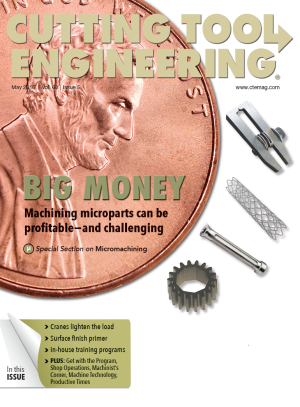Early in my stint here, I called Alan Baker, founder of toolmaker A.B. Tools Inc., in connection with an article I was writing about thread milling small-diameter holes.
I started the interview with a general question about available thread mills sizes for these applications and was encouraged to first gather that information from Machinery’s Handbook and then call him back. I thanked him before ending the call and turning to the appropriate section of “The Bible of the Mechanical Industries,” published by Industrial Press Inc.
With that knowledge in hand, I called back and had an informative conversation. As a side note, Baker wrote a number of articles for CTE back in the mid-to-late-1960s when he was with Lockheed Missiles & Space Co., and, although metalcutting technology has advanced by leaps and bounds since then, much of the material is still relevant today.
I mention this exchange because I just received a review copy of the new 30th edition of Machinery’s Handbook, by Erik Oberg, Franklin D. Jones, Holbrook L. Horton and Henry H. Ryffel. (It’s good to be the editor.) On my bookshelf, it will accompany my printed copies of the 22nd and 29th editions, as well as a CD-ROM of the 27th edition and the book Machinery’s Handbook Made Easy by Edward T. Janecek.
While the handbook is chock-full of tantalizing illustrations and reference tables, I mainly read it for the articles. For example, the micromachining section includes information about the requirements for machine tools, cutting tools, workpiece materials and cutting fluids. To read about micromachining in our May 2016 issue, turn to the special section that starts on page 38.
In addition to the written word, the spoken word can effectively disseminate machining information. I experienced that April 5 in Chicago at Tungaloy America Inc.’s TungForce new-product campaign. The featured speaker for the product launch was Jacob Harpaz, president and CEO of IMC (International Metalworking Cos.) Group. IMC has numerous member-companies under its umbrella, and I’ve previously attended three other day-long presentations by Harpaz: two for Iscar Metals Inc. and one for Ingersoll Cutting Tools.
Harpaz is effective at conveying his message about how a toolmaker’s new products will benefit end users because he employs the three techniques that popular musicians, for example, use to get their creations to stick in listeners’ minds: repetition, repetition, repetition.
To emphasize Tungaloy’s ongoing R&D efforts, Harpaz noted 40 percent of its revenue is from tools less than 5 years old.
One familiar theme that Harpaz explored was how parts manufacturers can reduce their production costs—up to 15 percent or more—by running cutting tools at higher speeds and feeds. This savings compares with only an approximate 3 percent savings if the tools were supplied free of charge and a roughly 1.5 percent cost reduction when doubling tool life. Boosting machining parameters is a well-established route to gaining a competitive edge that’s worth hearing again.

BTW: I’d like to welcome Senior Editor Mike Anderson as the newest member of CTE’s editorial team.
Related Glossary Terms
- gang cutting ( milling)
gang cutting ( milling)
Machining with several cutters mounted on a single arbor, generally for simultaneous cutting.
- metalcutting ( material cutting)
metalcutting ( material cutting)
Any machining process used to part metal or other material or give a workpiece a new configuration. Conventionally applies to machining operations in which a cutting tool mechanically removes material in the form of chips; applies to any process in which metal or material is removed to create new shapes. See metalforming.
- metalworking
metalworking
Any manufacturing process in which metal is processed or machined such that the workpiece is given a new shape. Broadly defined, the term includes processes such as design and layout, heat-treating, material handling and inspection.
- milling
milling
Machining operation in which metal or other material is removed by applying power to a rotating cutter. In vertical milling, the cutting tool is mounted vertically on the spindle. In horizontal milling, the cutting tool is mounted horizontally, either directly on the spindle or on an arbor. Horizontal milling is further broken down into conventional milling, where the cutter rotates opposite the direction of feed, or “up” into the workpiece; and climb milling, where the cutter rotates in the direction of feed, or “down” into the workpiece. Milling operations include plane or surface milling, endmilling, facemilling, angle milling, form milling and profiling.
- turning
turning
Workpiece is held in a chuck, mounted on a face plate or secured between centers and rotated while a cutting tool, normally a single-point tool, is fed into it along its periphery or across its end or face. Takes the form of straight turning (cutting along the periphery of the workpiece); taper turning (creating a taper); step turning (turning different-size diameters on the same work); chamfering (beveling an edge or shoulder); facing (cutting on an end); turning threads (usually external but can be internal); roughing (high-volume metal removal); and finishing (final light cuts). Performed on lathes, turning centers, chucking machines, automatic screw machines and similar machines.


